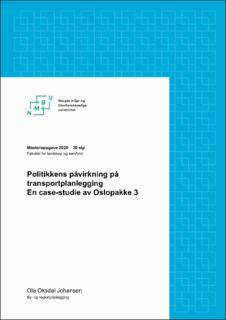| dc.contributor.advisor | Richardson, Tim | |
| dc.contributor.author | Johansen, Ola Oksdøl | |
| dc.coverage.spatial | Norway, Oslo | en_US |
| dc.date.accessioned | 2021-01-12T16:37:41Z | |
| dc.date.available | 2021-01-12T16:37:41Z | |
| dc.date.issued | 2020 | |
| dc.identifier.uri | https://hdl.handle.net/11250/2722650 | |
| dc.description.abstract | Transport av mennesker er en sentral del av det moderne samfunn. Hvordan det planlegges for transport påvirker mangt, fra menneskers hverdag til det globale klimaet. Det ble på 1900- tallet planlagt for den da nye mobilitetsformen, personbilen. Synet på klimautfordringene ble endret mot slutten av 1900-tallet. Dette førte til at transportplanlegging ble mer klimaorientert. Som et resultat av dette ble planlegging for bilen regnet som utdatert. På tross av dette vedtas det fortsatt å bygge kapasitetsøkende veinfrastruktur. Det er mange aktører som kan påvirke planlegging. En av aktørene med makt i planlegging er politikere. Politikeres vedtaksmakt i norsk planlegging fører til at politiske partier påvirker transportplanlegging.
Denne oppgaven ser politiske partiers forskjellige tolkning av transportplanlegging. Det er gjort en case-studie av Oslopakke 3. Oslopakke 3 er en bypakke for Oslo og Akershus/Viken. Pakken inneholder en prosjektportefølje som har som formål å forbedre Osloregionens transportsystem. En rekke vei-, kollektiv, sykkel- og gangprosjekter utgjør prosjektporteføljen. Flerpartisystem og et sterkt lokaldemokrati er noen av kjennetegnene ved norsk politikk. Lokalpolitikernes påvirkningskraft på bypakker, og partiers forskjellige tolkninger av transportplanlegging påvirker Oslopakke 3. Dynamikken mellom overordnede føringer for klima, målbildet i Oslopakke 3 og det faktiske innholdet i prosjektporteføljen er gjenstand for analyse. | en_US |
| dc.description.abstract | The transport of people is a key part of modern society. How we plan for transport affects a number of things, from the everyday life of people to the global climate. In the 20th century, the car was the main focus of transport planning. Climate change became a global focus towards the end of the 20th century. As a result of this, transport planning was conducted in a more climate-oriented way. The car was no longer a part of this sustainable future. Despite this, there are still being built road infrastructure that increases the capacity of the car. There are many actors that can affect planning. An actor with power in planning is politicians. In Norway, planning decisions are made by the politicians. This leads to the political parties affecting transport planning.
This thesis will look at political parties’ different interpetations of transport planning. There has been conducted a case-study of Oslo Package 3. Oslo Package 3 consists of public transport, road, bicycle and pedestrian measures for Oslo and Akershus/Viken. The characteristics of the Norwegian political system is a multi-party system and a strong local democracy. The local politicians influence on packages such as Oslo Package 3, and the different parties’ interpretations of transport planning affects the outcome of the package. The dynamic between superior guidelines for climate, the goals for Oslo Package 3 and the actual content of the package is subject to analysis. | en_US |
| dc.language.iso | nob | en_US |
| dc.publisher | Norwegian University of Life Sciences, Ås | en_US |
| dc.rights | Attribution-NonCommercial-NoDerivatives 4.0 Internasjonal | * |
| dc.rights.uri | http://creativecommons.org/licenses/by-nc-nd/4.0/deed.no | * |
| dc.title | Politikkens påvirkning på transportplanlegging : en case-studie av Oslopakke 3 | en_US |
| dc.type | Master thesis | en_US |
| dc.source.pagenumber | 94 | en_US |
| dc.description.localcode | M-BYREG | en_US |

